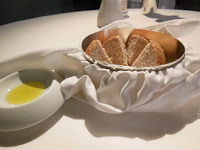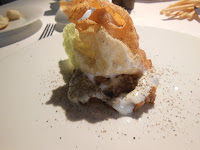Since I have been to two of the top three restaurants in San Pellegrino list (namely El Celler de can Roca & Noma), I decided to make a detour to Modena from my trip to Northern Italy for a fine dining occasion at Osteria Francescana. I had high expectation for this meal.
Owner/Chef Massimo Bottura is renowned for his creativeness on Italian culinary traditions. He loves contemporary arts which are displayed in the restaurant. His love for contemporary arts is reflected in the style and naming of Francescana’s dishes (“Memories of a Mortadella Sandwich”, “An Eel Swimming Up the Po River”)
The restaurant has two dining rooms with a maximum capacity of 30 guests. It is situated at the corner of via Stella and via delle Rose near the edge of the old town and occupies both northeast and northwest buildings at the corner along via Stella. The entrance to the dining room and main kitchen are at the northwest corner building. Cross the street of via Rose, it has back office operation, staff recreation room and preparation room for the kitchen.
There are three types of menus – a la carte, Tradition in Evolution tasting menu and Sensation tasting menu. While Tradition in Evolution tasting menu is mainly comprised of its signature dishes, Sensation tasting menu is comprised of new inventions in progress. I, therefore, chose the Tradition in Evolution.
It was a surprise that bread and virgin olive oil were served before any appetizer was brought to the table.
1st Course – Memory of A Mortadella Sandwich Borlengo
This course was comprised of three items:
1).Gnocchi bread and an artistically squeezed mortadella cream ornament. It also had some cream of sweet garlic, pistachio and sweet garlic on the side. The mortadella cream tasted a bit like bologna, gnocchi bread is fluffy and fresh.
2). At the bottom was a thin layer of waffle made of Parmigiano cheese and flour. Waffle was topped with flakes made from Parmigiano cheese protein. Parmigiano cheese protein was derived from boiling cheese in water, let the protein settle at the bottom, drying the protein chunk and grating them into flakes. On top of the Parmigiano cheese flake was coarsely chopped truffles. Parmigiano cheese flakes had a lighter texture and milder taste than cheese itself.
2). At the bottom was a thin layer of waffle made of Parmigiano cheese and flour. Waffle was topped with flakes made from Parmigiano cheese protein. Parmigiano cheese protein was derived from boiling cheese in water, let the protein settle at the bottom, drying the protein chunk and grating them into flakes. On top of the Parmigiano cheese flake was coarsely chopped truffles. Parmigiano cheese flakes had a lighter texture and milder taste than cheese itself.
3). Rabbit macaroon – stewed rabbit was sandwiched in between macaroons. Rabbit was cooked with bell pepper and ground pepper, and was not spicy.
More varieties of bread were served - grissini, zoccolette, and Panini made from flour and rice flour.
2nd Course – “Foie Gras Ice Cream Bar with Traditional Balsamic Vinegar from Modena
Aged Balsamic Vinegar was filled inside a rectangular shaped foie gras lollipop. Then, foie gras was coated with toasted and chopped almond and hazelnuts. This is my favorite item in this meal, it was a true masterpiece with well-balanced taste.
3rd Course – An Eel Swimming Up the Po River
Eel was from the local Po River. It was cooked sous-vide in low temperature, that is then finished in the oven, and finally lacquered (broiled until sauce thickened) with Saba sauce (aged Balsamic vinegar.) Lastly, lacquered eel was sprinkled with black onion powder (grounded slow roasted onion). Eel was served with green apple jelly sauce on one side and polenta on the other side. This is a delightful Japanese-Italian fusion dish with a beautiful balance between freshness and richness. I am very fond of food cooked sous-vide because slow cooking makes for a more tender texture.
4th Course – Caesar Salad in Emilia
It was a baby Romano lettuce heart inserted with 22 ingredients in between the layers of lettuce leaves, including bacon, crispy Parmigiano, anchovies, 10 aromatic herbs, garlic sauce, egg sauce, balsamic vinegar, mustard seeds, egg yolk cream and yogurt. The lettuce itself and the inserts were sweet, fresh and tasty. It was a good salad, but was not stunning. I wondered this course was served as a palate cleanser for the following course.
5th Course - Five Ages of Parmigiano Reggiano in Different Temperatures and Textures
1). Parmigiano crisp, at room temperature, was made from 40-month cheese;
2). Parmigiano mousse that had a curd-like texture, at cold temperature, was made from 36-month old cheese;
3). Parmigiano cream, at cold temperature, was made from 24-month cheese;
4). Parmigiano demi-soufflé, coldest temperature in this course, was made from 30-month old cheese. Demi-soufflé is less airy, less fluffy and creamier
than soufflé.
5). Parmigiano air (lighter than foam), cold temperature, was made from 50-month old cheese.
This was another masterpiece and was my 2nd favorite.
6th Course – The Crunchy Part of the Lasagna
Three different kinds of flavored lasagna (tomato, spinach and original) were cooked, made into paste, dried and fried. They looked very different from their ordinary texture and form as a result of experimenting with molecular gastronomy. It was a true transformation. In the process, they can be made into different shapes and displayed any way you desired vs. the plain old lasagna appearance. These chips were served with Ragu sauce made of veal, pork and bone marrow. It involved a lot of work to transform lasagna into this fancy and artfully looking appearance. But, was the taste incrementally enhanced commensurate with the incrementally enhanced appearance?
7th Course – Spin-painted Veal, not Flame Grilled
It was slow-cooked veal tenderloin surrounded by ashes (which looked grilled). It was served with beet, polenta, yellow pepper sauce, orange pepper sauce, balsamic vinegar and colorfield (in green). The small pile of white flakes were grated fresh horse radish. This dish was inspired by Damien Hirst’s painting at the entrance. This course is a true artful work. It had both the visual as well as palatial pleasure.
8th Course – La Torta di Riso
This is a dish of rice similar to the Five Aged Parmigiano. But, this dish did not offer much pleasure to the taste bud. It comprised of rice cream, licorice/rice granité, toasted rick cake slice (beautifully standing in the middle of the bowl) with anise jello in the cream. The little square piece at the bottom of the bowl was bergamot.
9th Course – Oops! I dropped the Lemon Tart
VignolaThe course was comprised of two deserts:
1). Lemon Tart – This is one of Osteria Francescana's signature dishes, made to look like someone dropped the lemon tart, served on a specially designed plate. Lemon sabayon cream at the bottom and topped with cream and then butter tart. Served on the side with green mint, bergamot, lemon pulp, caper, oregano, chili pepper. A well-thoughtfully constructed dish with a well-balanced sweet and citrus flavor.
2). Crispy chocolate cake (with a texture like cookie) at the bottom, topped with a chocolate filled with cherry liquor and cherry sauce inside.
Petit Four – from left to right, mini lemon meringue cake, chocolate with almond, chocolate with hazelnut and passion fruit with coffee. My favorite was passion fruit with coffee. I later met the pastry chef in its kitchen, she informed me this item was a new invention.
After the meal, I had the opportunity to visit its kitchen and met its head chef Takahiko Kondo who is a Japanese. Its kitchen is divided by section and has about 24 staff members.
It was a unique and nice experience to dine at Francescana. Its cuisine was creative, with a lot of focus on the transformation of form and artistic presentation. It delivered Emilia Romania region’s produce and traditions in an ultra-contemporary approach. Two years ago, I dined at the #1 restaurant El Celler de can Roca and have thought of revisiting it ever since. To compare, the current price of tasting menu at Roca is 195 Euro (for 14-courses & multi-course of Amuse Bouche, and more lavish ingredients) and at Francescana is 175 Euro (7-courses and no Amuse Bouche.) I dearly miss Roca.


























No comments:
Post a Comment